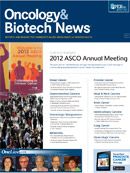Plenary Sunday at ASCO
A well-designed study involving hundreds of patients for many years can lead to one- to two-sentence conclusions that create the new standard of care; this year's Plenary Session on Sunday at ASCO was no exception.
Andrew L. Pecora, MD
Editor-in-Chief
Oncology & Biotech News
Chief Innovations Officer, Professor, and Vice President of Cancer Services John Theurer Cancer Center at Hackensack University Medical Center
I am sure any of us can think of many other things to do for over four hours on a Sunday afternoon. However, it is hard to beat a plenary at the ASCO Annual Meeting to get the scientific and clinical juices going, despite the uncomfortable chairs. In addition to a provocative lecture given by Rakesh K. Jain, PhD, of Harvard Medical School and Massachusetts General Hospital, winner of the ASCO Science of Oncology Award, four abstracts addressing treatments of metastatic breast cancer, anaplastic oligodendroglioma, advanced lowgrade lymphoma, and metastatic prostate cancer were presented with expert commentary at the 2012 ASCO Plenary Session.
Jain has spent a lifetime addressing the clinical relevance of tumor bed vascular flow. He unequivocally dispelled the notion that decreasing blood flow to a tumor is of therapeutic value, and paradoxically showed that the clinical benefit imparted by current antiangiogenic therapeutics is a consequence of normalizing (improving) blood flow to the tumor. Jain’s work shows that normalization of tumor blood flow decreases intratumoral interstitial pressure and reduces tissue tumor hypoxia, allowing for greater antineoplastic drug and immunologic tumor cell killing. Jain has taught all of us that too little or too much antiangiogenesis therapy is equally infective, and that using just enough needed to normalize tumor blood flow is “just right.”
Kimberly L. Blackwell, MD, Duke Cancer Institute, and the EMILIA study group next regaled the audience with a large prospective randomized comparison of an antibody (trastuzumab) cytotoxic (DM-1) conjugate (anti-tubulin), known as TDM-1, with standard capecitabine and lapatinib in women with metastatic breast cancer that had progressed after taxane and trastuzumab therapy. Strikingly, the TDM-1 group experienced significantly better progression-free survival (PFS; 9.6 vs 6.4 months; hazard ratio [HR] = 0.65; P <.0001) and better overall survival (OS) at 24 months (65.4% versus 47.5%; HR = 0.62; P <.0005). The best news, however, was that the antibody conjugate was better tolerated than the standard treatment.
Not to be outdone by the breast cancer crowd, the European Organisation for Research and Treatment of Cancer presented long-term follow-up on a comparison of radiation (after best-effort surgery) to radiation and chemotherapy in patients with anaplastic oligodendrogliomas. At 12 years’ follow-up, the chemotherapy plus radiation group had significantly better PFS (24 vs 13 months; P = .003) and overall survival (42 vs 31 months; P = .018). These data would not have been presented during the plenary session without the seminal observation that the benefit of chemotherapy resided largely in the subgroup of patients found (much later) to have a malignant cell genetic mutation (1p/19q).
Even though this was an ASCO and not an ASH meeting, lymphoma made it to the plenary session. The one tried-and-true regimen for low-grade non-Hodgkin lymphoma, CHOP, now has competition. But unlike most of the plenary session’s drug combinations, which originated from recent molecular lab discoveries, the lymphoma treatment combination that was discussed originates from work done in the late 1970s in what was then Eastern Germany. Bendamustine—an alkylating agent developed at that time—combined with rituximab produced superior outcomes and fewer toxicities than CHOP plus rituximab in patients with indolent and mantle cell lymphomas.
Last but definitely not least was the observation that treatment of hormone-responsive prostate cancer with continuous androgen blockade resulted in superior outcomes long term among some patients with minimal but not extensive disease.
I have always been humbled by how data from a well-designed study involving hundreds of patients for many years can lead to one- to two-sentence conclusions that create the new standard of care; this year’s Plenary Session on Sunday at ASCO was no exception.




